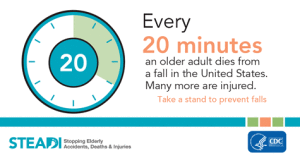October 28th, 2015
Much Ado About a Fall
Charity Maniates, MSPA, MPH, PA-C
At 3:00 AM the pager furiously buzzes on my bedside table, jolting me out of sleep. I grapple with my iPhone and call the nursing facility to address the emergency. The nurse brightly reports that a patient had a fall without injury — her third that weekend. That is all. Not quite the caliber of emergency requiring a middle-of-the-night update.
To be fair, the nurse was technically adhering to facility protocol. CMS requires long-term care and skilled facilities to report copious amounts of data on 18 quality measures including falls, pressure ulcers, and UTIs. This necessitates calls to providers at ungodly hours to report even a skin tear. For a physician assistant practicing in geriatrics, notifications of falls occur frequently, but a cluster of falls may herald infection, delirium, medication effect, hypotension, or advancing dementia and therefore warrants a review of medications and a patient visit.
After the three falls, I visit with Ann, an 88-year-old woman — blue-eyed with wavy, white hair — who is laying on her bed, hands on her stomach, watching TV. Her husband, also her caretaker for many years, sits quietly next to her with the TV clicker in hand. Ann flashes me a smile and says, “I just slipped out of bed,” evidently not recalling repeated reminders to press the call bell for help.
 Sitting on Ann’s bed in her small room, we discuss her history of falls at home, her current medications, and medical risk factors contributing to her recent weekend falls. During her last hospitalization, she was diagnosed with polycythemia vera resulting in mesenteric ischemia requiring phlebotomies and atrial fibrillation with RVR. She has a history of normal-pressure hydrocephalus s/p shunt and, according to her husband, a previous diagnosis of Parkinson’s disease. Medication culprits for falls: digoxin, amiodarone, metoprolol, and lisinopril. Labs at my visit show stable hematocrit and electrolytes but an elevated TSH of 48 and a morning blood pressure of 87/56. I note worsening cogwheel rigidity and tremors on exam.
Sitting on Ann’s bed in her small room, we discuss her history of falls at home, her current medications, and medical risk factors contributing to her recent weekend falls. During her last hospitalization, she was diagnosed with polycythemia vera resulting in mesenteric ischemia requiring phlebotomies and atrial fibrillation with RVR. She has a history of normal-pressure hydrocephalus s/p shunt and, according to her husband, a previous diagnosis of Parkinson’s disease. Medication culprits for falls: digoxin, amiodarone, metoprolol, and lisinopril. Labs at my visit show stable hematocrit and electrolytes but an elevated TSH of 48 and a morning blood pressure of 87/56. I note worsening cogwheel rigidity and tremors on exam.
Her husband voices his only goal for her care: to ensure her safety and prevent a traumatic fall resulting in a hospitalization. At the end of the visit, levothyroxine is increased, lisinopril is stopped, and low-dose sinemet is started to target Parkinson’s symptoms. Also, bed rails are placed, mostly as a reminder. These are simple interventions in the realm of modern medicine but substantial in preventing a potential hip fracture, subdural hematoma, or fatality.
In this case, a federal requirement was effective — it stimulated a visit and, in turn, interventions that could ultimately reduce risk for a traumatic fall. Documenting this cascade of events requires numerous steps for facilities and, of course, a provider note. It should be straightforward, right? The recently launched ICD-10 offers 69,000 coding categories that are supposedly simpler and smarter than the outdated 14,000 ICD-9 codes. There must be one glorified code that encapsulates The Geriatric Fall. Of the 19 headings for falls, “Fall from nonmoving wheelchair” is applicable but minimizes the situation. ICD-10 experts tout the updated codes for revealing snapshots of complex medical issues, providing clarity for providers, and capturing accurate, national data. In reality, ICD-10 requires providers to spend an additional 5 minutes of documentation for each patient encounter. Let me be clear, ICD-10: One seven-digit code does not capture the nuances of a patient visit. It’s ludicrous to even assert that it’s possible.
In the end though, I remind myself that complexity and diversity of patient care is what lured me into medicine, not the intricacy of coding or tedious documentation processes. In geriatrics, it’s often small changes that make the most impact on quality of life, even though they might begin with a non-emergent page in the middle of the night.

; [/php]/images/AU000_cmaniates.jpg)

You’ve captured the essence that is Geriatric medicine quite well. Geriatrics is detail-oriented because the devil is often in the details!